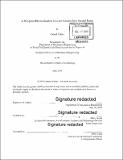A waypoint-driven gradient descent solution for a parallel robot
Author(s)
Valdes, Gabriel(Gabriel D.)
Download1130060354-MIT.pdf (4.111Mb)
Other Contributors
Massachusetts Institute of Technology. Department of Mechanical Engineering.
Advisor
Harry Asada.
Terms of use
Metadata
Show full item recordAbstract
This project aims to introduce a more robust navigation architecture for the Triple Scissor Extender Robot Arm (TSERA) at the d'Arbeloff Laboratory for Information Systems and Technology. TSERA was developed to access a confined area through a narrow channel, commonly known as the last one-foot problem found in final assembly, inspection, and maintenance operations within the aviation, automobile, and industrial equipment industries. Inspired from plant growth mechanisms, the robot is built from a sequence of expandable segments that can each extend and tilt. The current path planning algorithm computes arm motion by solving a series of inverse kinematic relations for each segment. This requires a user input of a three-dimensional coordinate to a kinematics solver for a robot in a complex and unknown operating space with parasitic displacement characteristics. This new path-planning design allows users to instead input a desired orientation for an expandable segment, utilizes a gradient ascent algorithm to determine the three-dimensional coordinate that would allow for that desired orientation, and then creates waypoints across the path in order to ensure minimal displacement error and reduce chances of damage to the robot's motors all in realtime. This solution allows for a more intuitive user experience with TSERA and increases robustness of the robot itself.
Description
Thesis: S.B., Massachusetts Institute of Technology, Department of Mechanical Engineering, 2019 Cataloged from PDF version of thesis. Includes bibliographical references (page 26).
Date issued
2019Department
Massachusetts Institute of Technology. Department of Mechanical EngineeringPublisher
Massachusetts Institute of Technology
Keywords
Mechanical Engineering.